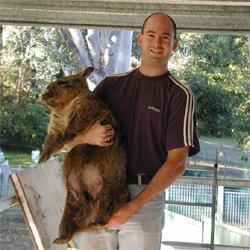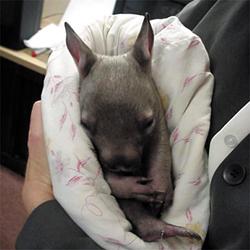Southern hairy-nosed wombat finds her home in Rockhampton
Published on 25 July, 2002
She’s smaller than a cat, has fur like a dog and looks like a baby kangaroo, but she is none of these. Kooloola is a southern hairy-nosed wombat – the newest addition to the Central Queensland’s Wombat Research Centre.
Kooloola, named after the property she was found on, came to the research centre as a newborn. She has since found her home with a wildlife carer and is being nurtured like a baby until she gains full independence.
The three-and-a-half-month-old, weighing just 1.7kg and reaching just 30cm in length, demands four milk feeds a day and remains warm in a flannelette, make-shift pouch. She will remain in this pouch until she is seven to eight-months-old. At this stage she will leave the pouch intermittently until she gains total independence at about nine to 10 months.
 The Morning Bulletin will monitor Kooloola’s growth and will publish monthly reports.
The Morning Bulletin will monitor Kooloola’s growth and will publish monthly reports.
Postgraduate research candidate at Central Queensland University Glenn Druery is researching the reproduction of the southern hairy-nosed wombat at the Rockhampton-based Research Centre. He predicts his research may see Kooloola becoming a surrogate mother for some of her young northern cousins in the future.
The Wombat Research Centre has been designed to help save the northern hairy-nosed wombat. The northern hairy-nosed wombat is one of the world’s most endangered mammals with only 110 surviving on one small national park in Central Queensland. Because the southern hairy-nosed wombats are closely related to the northern variety, they are currently being used at the Research Centre in an effort to develop assisted reproductive techniques for the endangered northern hairy-nosed wombat.
There are currently 15 southern hairy-nosed wombats at the Intensive Research Facility. Mr Druery is investigating reproductive functions in eight of those wombats – four males and four females. He is trying to determine if the wombats cycle at a time similar to those in the wild in South Australia. Blood sampling occurs once weekly, to look for changes in reproductive hormone levels across time.
Mr Druery is a clinical embryologist at Rockhampton’s IVF Clinic, Central Queensland Fertility (CQF). He has used his knowledge and experience from the clinic in his research of wombats. CQF is the industry-based partner in a unique relationship between CQU, and local and state governments (Rockhampton City Council and Queensland Parks and Wildlife).
“We are collecting blood sera once-weekly in an attempt to minimise the invasiveness of the sampling regime. This will still allow us to monitor changes in reproductive hormone levels in the wombats across time. We are correlating changes in pouch condition in females, and changes in accessory reproductive structures in males with reproductive hormone levels,” Mr Druery said.
 “With current data it looks like the sampling regime is having little effect on reproduction, as the wombat’s appear to be cycling in a similar time-frame to those animals in the wild population in South.
“With current data it looks like the sampling regime is having little effect on reproduction, as the wombat’s appear to be cycling in a similar time-frame to those animals in the wild population in South.
He said he has been looking at the use of IVF principles on wild-caught female wombats, investigating ovarian response to the reproductive hormones FSH, PMSG and LH. Using these hormones, Mr Druery has demonstrated that it is possible to stimulate wombat ovaries to develop multiple oocytes (eggs). He plans to conduct a similar study on the remaining females in the captive population at the Intensive Research Facility at the Rockhampton Zoo later in the year. The successful development of an ovarian follicular superstimulation protocol will undoubtedly lead to the next step in trying to save the endangered northern hairy-nosed wombat – artificial insemination” The Central Queensland Wombat Research Centre is a joint initiative between the Rockhampton City Council, CQ Fertility, Queensland Parks and Wildlife Service and the Central Queensland University.
Photo left: Glen Druery and Winnie.
Photo above: Kooloola

